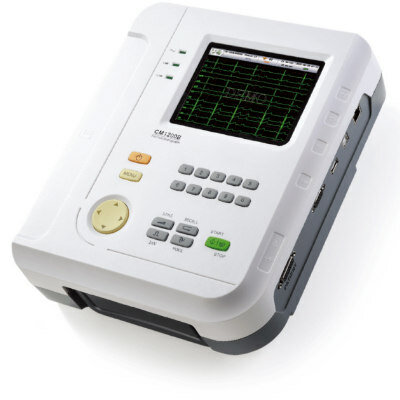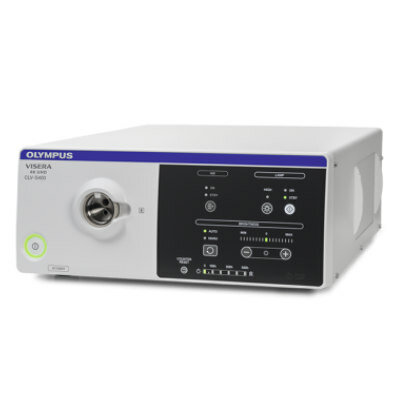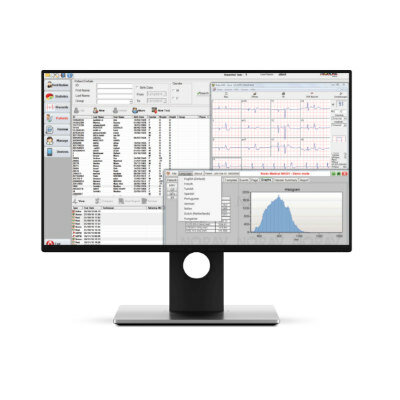Diagnostic Technique Assesses Structural Changes in Cardiac Arrhythmia to Enable Personalized Treatment
|
By HospiMedica International staff writers Posted on 07 Aug 2023 |

Atrial fibrillation, one of the most common types of cardiac arrhythmia, is characterized by irregular and rapid heartbeats that can lead to the formation of blood clots in the heart. This increases the risk of stroke, heart failure, and other related complications. Currently, atrial fibrillation is classified based on the duration of the arrhythmia, but this temporal classification does not provide information about the extent of structural and electrophysiological changes, known as atrial remodeling, that occur in the hearts of patients with atrial fibrillation. Atrial remodeling is a crucial parameter, especially in the initial months of the condition, as the underlying disease processes can progress at different rates. Now, a new diagnostic method allows for the simultaneous assessment of both electrical and mechanical (contractile) activity in the heart atria during atrial fibrillation, enabling timely intervention and better management of the condition.
Over the past 10 years, a team of national and international experts led by scientists at the Centro Nacional de Investigaciones Cardiovasculares (CNIC, Madrid, Spain) has been collaborating to integrate electrical and mechanical cardiac data in order to enable personalized characterization of the pathological changes associated with the progression of atrial fibrillation. The researchers were successful in achieving this through a multidisciplinary approach. Engineers and physicists worked together in the initial phase to devise the most suitable strategy for integrating the electrical and mechanical data. They found a solution to measure mechanical activity by using Doppler imaging, which offers a noninvasive method of providing information on atrial tissue movements, and to measure electrical activity by utilizing surface electrocardiography.
Both approaches are easy to implement in a clinical setting since they are noninvasive and can be performed during a transthoracic ultrasound examination, a routine study of the heart's shape and function along with some internal structures. The second phase involved experts in biology, biotechnology, biochemistry, and biomedical engineering working in collaboration with the CNIC Proteomics Unit and clinical cardiologists. Experimental studies in this phase correlated the information obtained through the new approach with underlying pathological changes in atrial tissue. This led to the development of advanced mapping techniques and computer simulations that shed light on the mechanisms underlying electrical and mechanical remodeling during the progression of atrial fibrillation.
In the final phase, a multicenter prospective study involving 83 patients in the early stages of atrial fibrillation was conducted to determine the prognostic value of simultaneously assessing electrical and mechanical activity in the atria of these patients. The experimental and clinical findings revealed an imbalance between electrical and mechanical activation in the atria during the early stages of the disease. This causes dissociation between the two parameters, termed "atrial electromechanical dissociation," where the contractile activation cannot keep up with the electrical activation. This phenomenon is specific to each individual patient and is usually observed within the first 2-3 months after an uninterrupted atrial fibrillation episode. A key advantage of this new approach is that it identifies atrial electromechanical dissociation before overt clinical signs of structural atrial remodeling appear. This early detection could be crucial for timely intervention and better management of the condition.
“The use of this new diagnostic approach allows early characterization of the underlying remodeling in patients with atrial fibrillation,” said study leader David Filgueiras. “The study shows that it is possible to integrate electrical and mechanical data from the atria of patients with atrial fibrillation to obtain personalized prognostic information about the clinical progression of the disease.”
Related Links:
CNIC
Latest Critical Care News
- Deep-Learning Model Predicts Arrhythmia 30 Minutes before Onset
- Breakthrough Technology Combines Detection and Treatment of Nerve-Related Disorders in Single Procedure
- Plasma Irradiation Promotes Faster Bone Healing
- New Device Treats Acute Kidney Injury from Sepsis
- Study Confirms Safety of DCB-Only Strategy for Treating De Novo Left Main Coronary Artery Disease
- Revascularization Improves Quality of Life for Patients with Chronic Limb Threatening Ischemia
- AI-Driven Prediction Models Accurately Predict Critical Care Patient Deterioration
- Preventive PCI for High-Risk Coronary Plaques Reduces Cardiac Events
- AI Diagnostic Tool Guides Rapid Diagnosis and Prediction of Sepsis
- World's First AI-Powered Sepsis Alert System Detects Sepsis in One Minute
- Smartphone Magnetometer Uses Magnetized Hydrogel to Measure Biomarkers for Disease Diagnosis
- New Technology to Revolutionize Valvular Heart Disease Care
- Super Permeable Wearable Electronics Enable Long-Term Biosignal Monitoring
- New Hydrogel Features Enhanced Capabilities for Treating Aneurysms and Halting Progression
- New AI Tool Predicts Medical Events to Support Clinical Decision-Making in Healthcare Settings
- Bioelectronic Mesh Grows With Cardiac Tissues for Comprehensive Heart Monitoring
Channels
Artificial Intelligence
view channel
AI-Powered Algorithm to Revolutionize Detection of Atrial Fibrillation
Atrial fibrillation (AFib), a condition characterized by an irregular and often rapid heart rate, is linked to increased risks of stroke and heart failure. This is because the irregular heartbeat in AFib... Read more
AI Diagnostic Tool Accurately Detects Valvular Disorders Often Missed by Doctors
Doctors generally use stethoscopes to listen for the characteristic lub-dub sounds made by heart valves opening and closing. They also listen for less prominent sounds that indicate problems with these valves.... Read moreSurgical Techniques
view channel
Hydrogel-Based Miniaturized Electric Generators to Power Biomedical Devices
The development of engineered devices that can harvest and convert the mechanical motion of the human body into electricity is essential for powering bioelectronic devices. This mechanoelectrical energy... Read moreWearable Technology Monitors and Analyzes Surgeons' Posture during Long Surgical Procedures
The physical strain associated with the static postures maintained by neurosurgeons during long operations can lead to fatigue and musculoskeletal problems. An objective assessment of surgical ergonomics... Read more.jpg)
Custom 3D-Printed Orthopedic Implants Transform Joint Replacement Surgery
The evolving field of 3D printing is revolutionizing orthopedics, especially for individuals requiring joint replacement surgeries where traditional implants fail to provide a solution. Although most people... Read more
Cutting-Edge Imaging Platform Detects Residual Breast Cancer Missed During Lumpectomy Surgery
Breast cancer is becoming increasingly common, with statistics indicating that 1 in 8 women will develop the disease in their lifetime. Lumpectomy remains the predominant surgical intervention for treating... Read morePatient Care
view channel
Surgical Capacity Optimization Solution Helps Hospitals Boost OR Utilization
An innovative solution has the capability to transform surgical capacity utilization by targeting the root cause of surgical block time inefficiencies. Fujitsu Limited’s (Tokyo, Japan) Surgical Capacity... Read more
Game-Changing Innovation in Surgical Instrument Sterilization Significantly Improves OR Throughput
A groundbreaking innovation enables hospitals to significantly improve instrument processing time and throughput in operating rooms (ORs) and sterile processing departments. Turbett Surgical, Inc.... Read more
Next Gen ICU Bed to Help Address Complex Critical Care Needs
As the critical care environment becomes increasingly demanding and complex due to evolving hospital needs, there is a pressing requirement for innovations that can facilitate patient recovery.... Read moreGroundbreaking AI-Powered UV-C Disinfection Technology Redefines Infection Control Landscape
Healthcare-associated infection (HCAI) is a widespread complication in healthcare management, posing a significant health risk due to its potential to increase patient morbidity and mortality, prolong... Read moreHealth IT
view channel
Machine Learning Model Improves Mortality Risk Prediction for Cardiac Surgery Patients
Machine learning algorithms have been deployed to create predictive models in various medical fields, with some demonstrating improved outcomes compared to their standard-of-care counterparts.... Read more
Strategic Collaboration to Develop and Integrate Generative AI into Healthcare
Top industry experts have underscored the immediate requirement for healthcare systems and hospitals to respond to severe cost and margin pressures. Close to half of U.S. hospitals ended 2022 in the red... Read more
AI-Enabled Operating Rooms Solution Helps Hospitals Maximize Utilization and Unlock Capacity
For healthcare organizations, optimizing operating room (OR) utilization during prime time hours is a complex challenge. Surgeons and clinics face difficulties in finding available slots for booking cases,... Read more
AI Predicts Pancreatic Cancer Three Years before Diagnosis from Patients’ Medical Records
Screening for common cancers like breast, cervix, and prostate cancer relies on relatively simple and highly effective techniques, such as mammograms, Pap smears, and blood tests. These methods have revolutionized... Read morePoint of Care
view channel
Critical Bleeding Management System to Help Hospitals Further Standardize Viscoelastic Testing
Surgical procedures are often accompanied by significant blood loss and the subsequent high likelihood of the need for allogeneic blood transfusions. These transfusions, while critical, are linked to various... Read more
Point of Care HIV Test Enables Early Infection Diagnosis for Infants
Early diagnosis and initiation of treatment are crucial for the survival of infants infected with HIV (human immunodeficiency virus). Without treatment, approximately 50% of infants who acquire HIV during... Read more
Whole Blood Rapid Test Aids Assessment of Concussion at Patient's Bedside
In the United States annually, approximately five million individuals seek emergency department care for traumatic brain injuries (TBIs), yet over half of those suspecting a concussion may never get it checked.... Read more
New Generation Glucose Hospital Meter System Ensures Accurate, Interference-Free and Safe Use
A new generation glucose hospital meter system now comes with several features that make hospital glucose testing easier and more secure while continuing to offer accuracy, freedom from interference, and... Read moreBusiness
view channel
Johnson & Johnson Acquires Cardiovascular Medical Device Company Shockwave Medical
Johnson & Johnson (New Brunswick, N.J., USA) and Shockwave Medical (Santa Clara, CA, USA) have entered into a definitive agreement under which Johnson & Johnson will acquire all of Shockwave’s... Read more














